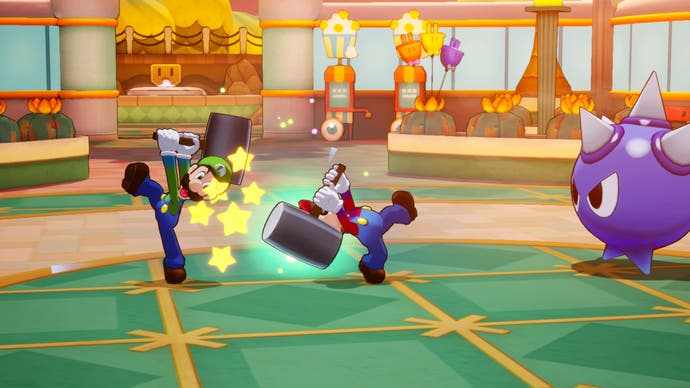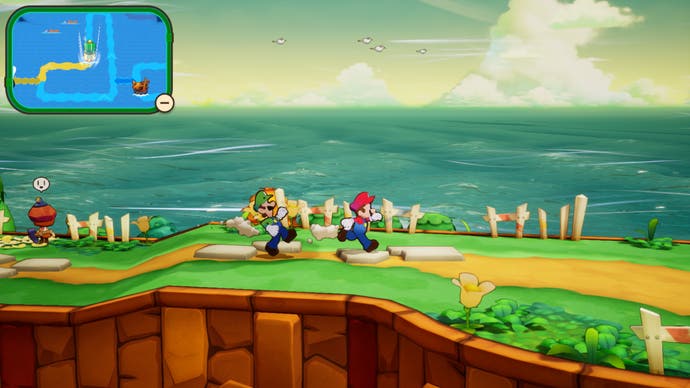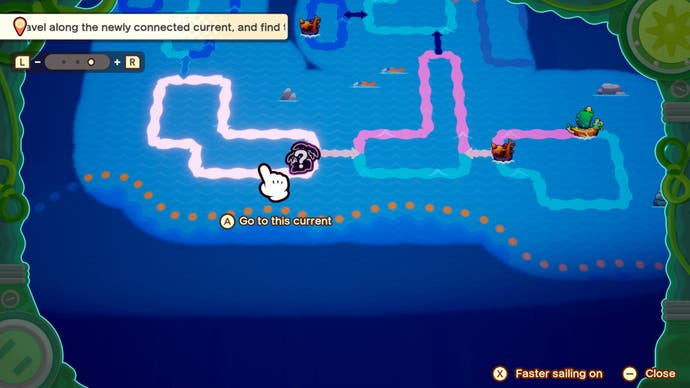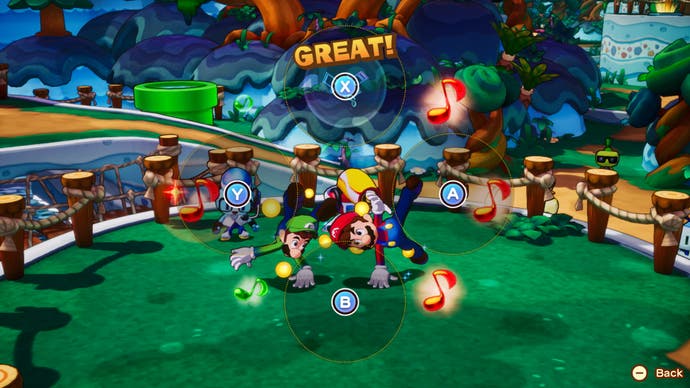Mario & Luigi Brothership charms its way through familial familiarity
Sibling revelry.
As the long-lived Switch heads towards the end of its life, Nintendo is playing out its veteran hardware with a symphony of familiar but not-quite-blockbuster takes on its biggest franchises. We've seen a retro-feeling Zelda that's not another open-world epic, and a final flurry of Mario spin-offs that will stretch into next year: another Mario vs Donkey Kong, one more Mario Party, and a port of Luigi's Mansion 2. The most interesting of Nintendo's last forays into the Mushroom Kingdom this generation, however, is the long-awaited return of its traditionally handheld-only Mario & Luigi series, whose previous all-new entry arrived nine years ago back on 3DS.
Fans of the Mario & Luigi games, which offer gentle RPG mechanics and platforming, humour and turn-based battles, will likely feel at home again here in this latest chapter that does not attempt to reinvent the wheel. (It's worth noting that Nintendo has said the game boasts some development staff from former entries in the series, despite long-term developer Alpha Dream sadly closing its doors back in 2015. Exactly who and how many have returned remains a mystery, however, due to Nintendo's continued secrecy around development credits prior to launch.)
As you'd expect, the Mario brothers are once again paired together in an adventure that always seeks to play up their partnership, with puzzles and gameplay designed around the concept of having two relatively-equal protagonists. Mario is technically still the star, as you control him for the vast majority of overworld exploration (while Luigi tags along automatically behind, running when Mario runs, jumping when Mario jumps). That said, the lankier brother still manages to get his time to shine. Separate buttons control each brother's hammer attack, used to clear obstacles and find power-ups. Specific to Luigi are moments and certain locations where he'll activate a new ability - Luigi Logic - with (fittingly) a press of the L button. It's at these moments you can detach him from Mario and send him off to smash crates and hoover up collectibles, or alternatively to perform some kind of specific gameplay in slightly-cerebral puzzles that require the two brothers to operate independently.
One of these puzzles involved navigating a circular maze, the two brothers separating from each other so Luigi can activate controls to rotate the maze's sections while Mario stands atop a lookout tower, the physical distance between the pair prompting the game's camera to zoom out so you get a birds-eye view of the solution. It's a neat way of communicating to the player that, within the game's fiction, Mario and Luigi are working together, dividing duties and - I like to think - calling back and forth as they shift the maze to and fro.
The brothers are equally as important in Brothership's turn-based battles, activated whenever an enemy scurries over and gets close enough to the duo, or if either brother is hit by a ranged attack. Enemies are everywhere and are tough to avoid on narrow pathways, which can make combat sometimes feel relentless when you just want to get where you're going. This is countered by the fact that battles can also be fled from with little penalty, and picking the in-battle option to run did not seem to not come with a chance of failure.
In moderation, then, battles are good fun - largely thanks to the series' blend of timed attack and defence mechanics. In gameplay that will also be familiar to Paper Mario veterans, Mario and Luigi take turns to either stomp on enemies or hit them with their hammers, with some foes requiring you do one rather than the other (as ever, jumping on spiky creatures and impaling your feet is a bad idea). More accurately-timed button presses here equal more powerful attacks, or longer attack combos as both brothers leap into action simultaneously. You can also use a limited resevoir of attack points to activate Bro Moves, special attacks that trigger a timed combo of button prompts featuring both brothers - for example, as they one-two Koopa shells between each other's feet before landing a devastating strike as a final flourish.

These attacks can grow a little repetitive, though various other Bro Moves will unlock as you progress for more variety. Battles can also be made to feel slightly different each time through the use of Battle Plugs (yes, that's the name Nintendo has gone with) which are essentially combat modifiers. You can activate a limited selection of Plugs at a time that each last a specific number of turns before requiring a cooldown. Some of the Plugs I saw increased damage, made status effects more likely, or made counter-attacks more easy. You'll also be able to craft your own Plugs later in the game, should you want to squeeze those in too.
Finally, a shout out to each enemy's varied attacks, which require close concentration in order to defend against. Aerial enemies can swoop down and carry a brother off, while others launch ranged attacks you have to leap to avoid. Still others circle you, requiring a well-timed counter hammer to knock away. Each enemy seems to have several attack patterns - some dashing all the off screen to then attack a different sibling on their way back - which certainly kept me on my toes. Fail to avoid an attack and your health quickly depletes, or you can be left with status effects that see you miss turns. Successfully repel an attack and you can avoid damage completely, plus also deal some additional pain on them if timed perfectly.
If there's a lot of detail on battles here, well, it's what I spent a good half of my time with Brothership doing as I made my way through a couple of early levels. Nintendo's keeping much of the game's narrative-heavy story under wraps for now, but the basics are as follows: Mario and Luigi are off exploring a new ocean kingdom, Concordia, inhabited by people and animals that have appliance-like features (a major ally, Snoutlet, is part piggy bank, part power socket). You have a hub area in the ship-shaped Shipshape Island, a floating isle whose course you chart via a sea map, and which traverses route-like sea currents to dock at various islands that act as the game's levels. These seem to offer a good amount of exploration potential, and are filled with characters to chat with and shops to browse for items that upgrade your abilities.




There's some light platforming here, but nothing early on that feels anything more than a simple nod to Mario's heritage. Most exploration is done on foot, no leaping required, though Mario and Luigi can unlock a number of other movement options - such as the odd ability to merge and transform into a UFO - a UF-Bro - that lets you float over to out-of-reach areas. I'm told more of these abilities become available later on.
Seeing the brothers turn into a spaceship, getting caught out by a tricksy enemy's attack pattern in combat, going on a quest to recover hair wax for a faded Concordian pop star - I found plenty in Mario & Luigi: Brothership that raised a smile. (And apart from its focus on the brothers, Mario & Luigi fans will also be happy to see several returning favourites pop up again, including series regular Starlow.) There may be much that's familiar about Brothership's formula, but after such a long absence it's a pleasure to be back in Mario and Luigi's company once more.


